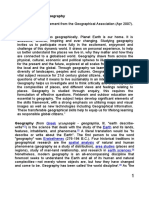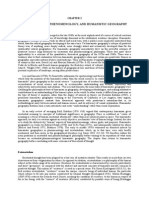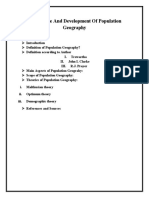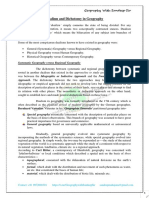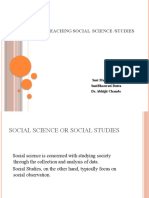0 ratings0% found this document useful (0 votes)
536 viewsEvolution of Geography: Greeks, Romans, Muslims and European Contribution
Evolution of Geography: Greeks, Romans, Muslims and European Contribution
Uploaded by
Gernatology Ag1. The Greeks made many early contributions to geography, including Homer describing the four winds, Thales proposing early geometric theorems, and Eratosthenes accurately measuring the Earth's circumference.
2. Roman geographers like Ptolemy improved on Greek maps by using a graticule of longitude and latitude, and the Muslim world advanced geography through travelers like Ibn Battuta and scholars like Al-Masudi and Al-Biruni who studied climates, landforms, and cultures around the world.
3. Geography continued to develop through the Middle Ages as geographers sought to better understand and represent the Earth, its lands, and relationship with human civilization.
Copyright:
© All Rights Reserved
Available Formats
Download as PPTX, PDF, TXT or read online from Scribd
Evolution of Geography: Greeks, Romans, Muslims and European Contribution
Evolution of Geography: Greeks, Romans, Muslims and European Contribution
Uploaded by
Gernatology Ag0 ratings0% found this document useful (0 votes)
536 views39 pages1. The Greeks made many early contributions to geography, including Homer describing the four winds, Thales proposing early geometric theorems, and Eratosthenes accurately measuring the Earth's circumference.
2. Roman geographers like Ptolemy improved on Greek maps by using a graticule of longitude and latitude, and the Muslim world advanced geography through travelers like Ibn Battuta and scholars like Al-Masudi and Al-Biruni who studied climates, landforms, and cultures around the world.
3. Geography continued to develop through the Middle Ages as geographers sought to better understand and represent the Earth, its lands, and relationship with human civilization.
Original Title
Evolution of Geography
Copyright
© © All Rights Reserved
Available Formats
PPTX, PDF, TXT or read online from Scribd
Share this document
Did you find this document useful?
Is this content inappropriate?
1. The Greeks made many early contributions to geography, including Homer describing the four winds, Thales proposing early geometric theorems, and Eratosthenes accurately measuring the Earth's circumference.
2. Roman geographers like Ptolemy improved on Greek maps by using a graticule of longitude and latitude, and the Muslim world advanced geography through travelers like Ibn Battuta and scholars like Al-Masudi and Al-Biruni who studied climates, landforms, and cultures around the world.
3. Geography continued to develop through the Middle Ages as geographers sought to better understand and represent the Earth, its lands, and relationship with human civilization.
Copyright:
© All Rights Reserved
Available Formats
Download as PPTX, PDF, TXT or read online from Scribd
Download as pptx, pdf, or txt
0 ratings0% found this document useful (0 votes)
536 views39 pagesEvolution of Geography: Greeks, Romans, Muslims and European Contribution
Evolution of Geography: Greeks, Romans, Muslims and European Contribution
Uploaded by
Gernatology Ag1. The Greeks made many early contributions to geography, including Homer describing the four winds, Thales proposing early geometric theorems, and Eratosthenes accurately measuring the Earth's circumference.
2. Roman geographers like Ptolemy improved on Greek maps by using a graticule of longitude and latitude, and the Muslim world advanced geography through travelers like Ibn Battuta and scholars like Al-Masudi and Al-Biruni who studied climates, landforms, and cultures around the world.
3. Geography continued to develop through the Middle Ages as geographers sought to better understand and represent the Earth, its lands, and relationship with human civilization.
Copyright:
© All Rights Reserved
Available Formats
Download as PPTX, PDF, TXT or read online from Scribd
Download as pptx, pdf, or txt
You are on page 1of 39
Evolution of Geography
Greeks, Romans, Muslims and European Contribution
Greek’s Contribution
• Homer
introduced the literary tradition through his monumental work
‘Odyssey’ and ‘Illiad’.
He described the four winds coming from different directions and
named them Boreas (North), Eurus (East), Notus (South) and Zephyrus
(West).
Homer
Thales
• Thales was the first Greek genius, philosopher, and traveler who was
concerned with the basic theorems of geometry.
• He proposed the following six geometric propositions –
i) The circle is divided into two equal parts by its diameter
ii) The angles at either end of the base of an isosceles triangle are equal iii)
When two parallel lines are crossed diagonally by a straight line, the
opposite angles are equal
iv) The angle in a semi-circle is a right angle
v) The sides of similar triangles are proportional
vi) Two triangles are congruent if they have two sides and one angle
respectively equal
Thales
Anaximander
• Anaximander is credited with the introduction of a Babylonian
instrument known as Gnomon into the Greek literary world.
• Gnomon is a pole set vertically above a flat surface on which the
varying position of the sun and other celestial bodies could be
measured by the length and direction of the shadow cast by the
vertical pole.
• He is even credited to produce a world map to scale.
Anaximander
Hecataeus
• Hecataeus for the first time gave two approaches for the study of
geography:
a) Nomothetic or law seeking approach.
b) Idiographic approach (descriptive).
• Hecataeus prepared the world map but it was based on the map of
Anaximander; he had just modified it.
Hecataeus
Herodotus
• Herodotus was the father of history. He is credited with the idea that
history must be treated geographically and all geography must be
treated historically.
• He is also identified as the father of ethnography as he provided a
vivid portrayal of cultural traits of people who were unknown to
Greeks
• His works were based on his own observations during his travels.
• He contributed both in physical and human geography.
Herodotus
Plato
• Plato is regarded as the master of deductive reasoning - from the
general to the particular.
• He is considered to be the first scholar who adopted the idea of round
earth located in the center of the universe with the other celestial
bodies revolving around it in a circular motion.
Plato
Aristotle
• Aristotle agreed with Plato that the earth is spherical in shape and
went a step further by seeking an explanation for the spherical shape.
• He even contributed to the branch of human geography when he put
forward the concept of variations in habitability on the surface of the
earth on the basis of latitudinal position.
• He opined that the regions nearer to the Equator were uninhabitable
and named it as the Torrid Zone.
• Similarly, the parts of the earth which was away from the Equator and
were permanently frozen were also uninhabitable – the Frigid Zone.
• The population of the Earth lived in the Temperate zone which existed
between the Torrid and the Frigid Zones
Aristotle
Eratosthenes
• Eratosthenes has been regarded as the ‘Father of Geography’.
• He is the one who coined the term Geography.
• He is credited to provide the definition of geography as the ‘’study of earth as
the home of man’’.
• His outstanding contribution for which he is known throughout the world is his
measurement of the earth’s circumference, by using Thales theorem – When
two parallel lines are crossed diagonally by a straight line, the opposite angles
are equal - while measuring the earth’s circumference
• He has also prepared a world map with respect to correct distance.
• He also delineated the world into five climatic zones: one Torrid Zone, two
temperate zones, and two frigid zones.
• He also measured different latitudes and longitudes.
Eratosthenes
Hippocrates
• Hippocrates in his book On Airs, Waters, Places explained the man-
nature relationship in the context of climatic conditions.
Hippocrates
Hipparchus
• Hipparchus established the concept of locating the exact position of
each place on the surface of the earth.
• On the basis of an Assyrian arithmetic, he divided the circle into 360
degrees.
• He made an attempt of showing the three-dimensional earth on a flat
surface.
Hipparchus
Strabo
• Strabo, a Greek scholar was highly influenced by Homer, Hecataeus
and Aristotle.
• He was in acceptance of Aristotle’s zones of habitable world – the
Ekumene (as defined by Eratosthenes).
• His biggest contribution is his monumental work ‘Geographia’ in 17
volumes; a compilation of writings of his predecessors. Out of these
17 books, eight are in Europe, six on Asia and one of Africa (Egypt and
Ethiopia). The first two books were devoted to the historical review of
the development of geography from the times of Homer.
Strabo
Roman Contribution to the field of
Geography
• Ptolemy revived the geography as a science and art of map-making. This
concept was borrowed from the works of earlier Greeks especially Aristotle,
Hipparchus, Posidonius and Marinus the Tyre (his teacher).
• He came up with a monumental work known as “The Almagest” – the
standard reference for the study of the movement of celestial bodies for a
long time.
• Another significant contribution of Ptolemy was in the field of map making.
• He improved and modified previous maps by adopting a projection for the
world map which had a graticule of meridians of longitude and parallels of
latitudes.
Ptolemy
Muslim Contribution in Geography
• Al-Balkhi
who collected climatic data from the accounts of various Arab travelers
and prepared the world’s first climatic atlas based on that data entitles
Kitab-Al Ashkal in 921.
Al-Balkhi
Al-Masudi
• Al-Masudi was a geographer, a historian a world traveler and a prolific writer.
• Al-Masudi described the weather conditions of the places he visited or sailed
through and also pointed out that the salt in the seas comes from the land.
• In the field of study of landforms he appreciated the role of process of
erosion and adjustment of streams to structure in the evolution of landforms
• He had a clear idea of the spherical shape of the earth.
• In the field of human geography he tried to study the relationship between
human beings and the environment and explained the impact of
environment on the mode life and attitude of people (environmental
determinism).
• He even divided the world into seven regions on the basis of language.
Al-Masudi
Al-Biruni
• His main interests include astronomy, mathematics, chronology, physics, medicine and
history.
• He describes the processes shaping the landforms under normal conditions.
• He provided detailed information about the source of Indus and explained the phenomena
of floods in its basin.
• He has provided an accurate account of the seasons of India describing the nature of
monsoons.
• He had also studied Indian culture and Hindu beliefs.
• He provided his views on the origin of universe.
• .He also attempt to measure the longest and the shortest distance of the moon and the sun
from the earth.
• He studied the relationship of tides with the phases of moon.
Al-Biruni
Ibn-Sina
• He gave the idea of landscape erosion when he observed that the
streams cut down their valleys when flowing down the mountains.
• He even examined the presence of fossils in the rocks in higher
mountains.
Ibn-Sina
Al idrisi
• His world map is considered as his most important contribution to
geography.
• He described the course of many rivers including the Danube and
Niger with precision.
• He did not agree with the Greek’s classification of the world into five
climatic divisions and provided a more sophisticated classification
based on climate.
Al idrisi
Ibn Batuta
• He was the greatest Muslim traveler of his time.
• He spent 28 years in travel and crossed a distance of more than 75000
miles.
• His primary interest was in people though he has described the
physical conditions of various regions that he visited.
• His description of house types and building materials in deserts is very
interesting and informative.
• His book Rihlah provides an insight into the soils, agriculture,
economy and political history of the then Muslim world.
Ibn Batuta
Ibn Khaldun
• Ibn Khaldun was basically a historian but his writings also have been
important as they were based on travel.
• His most important work is known as Muqaddimah.
• In his writings, Ibn Khaldun has maintained that the northern hemisphere
is more densely populated than the southern.
• He emphasized the role of fertile land in the origin of settlements.
• Ibn Khaldun is considered as one of the early environmental determinists
as he tried to correlate man and his environment in a scientific way.
• He is also credited of establishing political geography.
Ibn Khaldun
You might also like
- The Art of Forecasting Using Diurnal Charts - Sophia Mason - 2013 - Amer Federation of Astrologers Inc - 9780866903301 - Anna's ArchiveDocument77 pagesThe Art of Forecasting Using Diurnal Charts - Sophia Mason - 2013 - Amer Federation of Astrologers Inc - 9780866903301 - Anna's ArchivePeterNo ratings yet
- Perspectives in Human GeographyDocument32 pagesPerspectives in Human GeographyMritunjoy Roy100% (1)
- Geography As A Inter Diciplinary SubjctDocument12 pagesGeography As A Inter Diciplinary SubjctBarunMondal100% (2)
- Evolution of Geographical ThoughtDocument6 pagesEvolution of Geographical ThoughtKamini 1788100% (1)
- Political GeographyDocument21 pagesPolitical GeographyLexelyn Pagara Riva100% (1)
- Basic Concepts in GeographyDocument4 pagesBasic Concepts in GeographyAnna Louise Wy100% (1)
- Human Geography PDFDocument6 pagesHuman Geography PDFDaliya Chakroborty75% (4)
- Meaning Scope of Environment GeographyDocument15 pagesMeaning Scope of Environment GeographyAzeez AdegbiteNo ratings yet
- Introductory Module For GeographyDocument6 pagesIntroductory Module For GeographyJeffreynald Arante Francisco100% (1)
- Political Geography NotesDocument28 pagesPolitical Geography NotesMohaiminul Islam Bappy100% (1)
- Activity 1. Multiple-Choice Questions. (1 Point For Each Number)Document2 pagesActivity 1. Multiple-Choice Questions. (1 Point For Each Number)Norienne Teodoro50% (2)
- SST 101 I. History of Geography HGDocument10 pagesSST 101 I. History of Geography HGJomar CatacutanNo ratings yet
- Historical Development of GeographyDocument1 pageHistorical Development of GeographyJerome Alvarez0% (1)
- Nature of GeographyDocument17 pagesNature of GeographyZahidaWaseemNo ratings yet
- Lecture 3 The Science of GeographyDocument20 pagesLecture 3 The Science of GeographyJoseph Zotoo100% (1)
- Development of GeographyDocument17 pagesDevelopment of GeographyUdara Seneviratne100% (8)
- Historical Development of GeographyDocument24 pagesHistorical Development of GeographyAtul Sharma33% (9)
- History of Geographical ThoughtDocument25 pagesHistory of Geographical Thoughtfuturejns100% (3)
- Lecture 1. Intro To Geography PDFDocument46 pagesLecture 1. Intro To Geography PDFIanBiagtan100% (1)
- Introduction To Political GeographyDocument38 pagesIntroduction To Political Geographyashraf kabirNo ratings yet
- Difference Between Social Science and Social StudiesDocument3 pagesDifference Between Social Science and Social StudiesReynaldo Cantores Seidel Jr.No ratings yet
- Physical Geography NotesDocument2 pagesPhysical Geography Noteschuchaylopez7No ratings yet
- Geography: History of Geographic StudyDocument2 pagesGeography: History of Geographic StudyBryan Jhonson BathanNo ratings yet
- Environment Geography PDFDocument145 pagesEnvironment Geography PDFRahul SinghNo ratings yet
- Post Classical GermanDocument5 pagesPost Classical GermanVirendra PratapNo ratings yet
- Political GeographyDocument30 pagesPolitical GeographyTinisha PurohitNo ratings yet
- French Geographers: Phillippe Buache (1752)Document7 pagesFrench Geographers: Phillippe Buache (1752)Asna JaferyNo ratings yet
- Introduction To Physical GeographyDocument50 pagesIntroduction To Physical GeographyKunal Sawant100% (4)
- Agricultural GeographyDocument26 pagesAgricultural GeographyAnna Liese100% (1)
- Nature Scope and Content of Cultural Geography and Cultural DevelopmentDocument7 pagesNature Scope and Content of Cultural Geography and Cultural DevelopmentKaushiki KunduNo ratings yet
- Political Geography Lecture Note IN NEEEDDocument102 pagesPolitical Geography Lecture Note IN NEEEDJosophat Imfapachala100% (2)
- Contribution of American Geographers in Geography and RadicalismDocument8 pagesContribution of American Geographers in Geography and Radicalismchristine sNo ratings yet
- 1 The Origin of GeographyDocument5 pages1 The Origin of GeographyMahanie Abdulcarim100% (1)
- The Importance of GeographyDocument7 pagesThe Importance of GeographyImelda Arreglo-AgripaNo ratings yet
- Thinking Geographically: A Module in Physical Geography: Course Code: GEO1Document18 pagesThinking Geographically: A Module in Physical Geography: Course Code: GEO1mj100% (1)
- Existentialism, Phenomenology, and Humanistic GeographyDocument4 pagesExistentialism, Phenomenology, and Humanistic GeographyHidayat D. GatesNo ratings yet
- Development and Importance of Population Geography.Document16 pagesDevelopment and Importance of Population Geography.zumar shah100% (4)
- Evolution of Geographical Thought 6th Sem (H) CC13T 15 04 2020Document24 pagesEvolution of Geographical Thought 6th Sem (H) CC13T 15 04 2020Pankaj PharswanNo ratings yet
- Biography Theodore BrameldDocument3 pagesBiography Theodore BrameldMartha RussoNo ratings yet
- Dualism and Dichotomy in Geography: Geography With Sandeep SirDocument6 pagesDualism and Dichotomy in Geography: Geography With Sandeep SirSarveshVishnar100% (3)
- The Agricultural GeographyDocument35 pagesThe Agricultural GeographyTrisha Mae AlicnasNo ratings yet
- Books & Authors Geographer CornerDocument9 pagesBooks & Authors Geographer CornerTHE GEOGRAPHERNo ratings yet
- Humanistic Approach in GeographyDocument8 pagesHumanistic Approach in GeographySarveshVishnarNo ratings yet
- Geographic Thought PPT - Copy-1Document103 pagesGeographic Thought PPT - Copy-1Tezera Mark Tmh100% (3)
- Perspectives in Human Geography-1Document39 pagesPerspectives in Human Geography-1Kedar Bhasme100% (1)
- Possibilism Vs DeterminismDocument10 pagesPossibilism Vs DeterminismJohanna Monsad100% (1)
- Diversity and Spatial Differentiation in The CityDocument2 pagesDiversity and Spatial Differentiation in The CityZephyrine MendozaNo ratings yet
- Study Guide - Relationship Between Social Studies & Social ScienceDocument4 pagesStudy Guide - Relationship Between Social Studies & Social ScienceJosette BonadorNo ratings yet
- Sed SS 311 Chapter 1Document7 pagesSed SS 311 Chapter 1Klaimark Ramento CadelinaNo ratings yet
- 11 Geography Notes 01 Geography As A DisciplineDocument4 pages11 Geography Notes 01 Geography As A DisciplineAkash100% (3)
- Social Geography Definition and School of ThoughtDocument4 pagesSocial Geography Definition and School of ThoughtWicky Paswan100% (1)
- Bansal (Definition and Scope of Urban Geo) PDFDocument10 pagesBansal (Definition and Scope of Urban Geo) PDFOwen NaldozaNo ratings yet
- Pedagogy of Teaching Social ScienceDocument18 pagesPedagogy of Teaching Social ScienceDrMijanur RahamanNo ratings yet
- Introduction To GeographyDocument88 pagesIntroduction To GeographyRommel Laurenciano100% (2)
- Concept of Quantitative Revolution in GeographyDocument3 pagesConcept of Quantitative Revolution in Geographychristine sNo ratings yet
- Cultural Landscape and IdentityDocument37 pagesCultural Landscape and IdentityHajar SuwantoroNo ratings yet
- List of Geography BooksDocument1 pageList of Geography BooksArvind Paul0% (1)
- Different Approaches in Urban GeographyDocument4 pagesDifferent Approaches in Urban Geographysamim akhtar100% (1)
- The Five Themes in GeographyDocument7 pagesThe Five Themes in GeographyAlbert Grefal MatandagNo ratings yet
- Earlly Philosophers and GeographersDocument28 pagesEarlly Philosophers and Geographersphoenix7732678No ratings yet
- 4101 Lec 1Document14 pages4101 Lec 1Sakib MhmudNo ratings yet
- U3 Extra PracticeDocument4 pagesU3 Extra PracticeClaudia CuelloNo ratings yet
- Employee Motivational Meeting by SlidesgoDocument40 pagesEmployee Motivational Meeting by SlidesgoPerfect VideomakerNo ratings yet
- Sts ReviewerDocument10 pagesSts ReviewerReal AnNo ratings yet
- B.E. Degree, CA Test - I, January - 2021: V.R.S. College of Engineering and Technology, Arasur - 607 107Document1 pageB.E. Degree, CA Test - I, January - 2021: V.R.S. College of Engineering and Technology, Arasur - 607 107parth_iarjunNo ratings yet
- Science MagazineDocument12 pagesScience MagazineSantiago VelajNo ratings yet
- 10 Set QuestionsDocument10 pages10 Set QuestionsMamunNo ratings yet
- GR 3 Ls 12 Earth The Blue Planet NotesDocument16 pagesGR 3 Ls 12 Earth The Blue Planet Notesbwyw6xq58kNo ratings yet
- Year 5 - English - Question Paper - Second Semester Exam AnswersDocument13 pagesYear 5 - English - Question Paper - Second Semester Exam AnswersayaamaryNo ratings yet
- COMETS, METEORS and ASTEROIDSDocument3 pagesCOMETS, METEORS and ASTEROIDSCharo Nudo Pongasi100% (1)
- McGil University Final Exam Schedule Winter 2023Document17 pagesMcGil University Final Exam Schedule Winter 2023ddd ddNo ratings yet
- Universe Control CardsDocument9 pagesUniverse Control CardsGAIS SchoolNo ratings yet
- A Guide To Apocalyptic Cinema Mitchell - Charles PDocument436 pagesA Guide To Apocalyptic Cinema Mitchell - Charles PTülay ErtanNo ratings yet
- Suvremeni Uvid U Raspravu Mladoga BoškovićaDocument20 pagesSuvremeni Uvid U Raspravu Mladoga BoškovićasaxilirNo ratings yet
- Level VipDocument11 pagesLevel VipBakhtiyar Q.KhawajaNo ratings yet
- PrithviDocument1 pagePrithviRadomanSonjaNo ratings yet
- Science ReviewerDocument3 pagesScience ReviewerTeacher Liezel MacabangunNo ratings yet
- Coriolis - Hyaenas of Odacon (v1.2)Document32 pagesCoriolis - Hyaenas of Odacon (v1.2)Дмитрий Игошин0% (1)
- POWER Point Monthly Timeseries 2013 2022 007d2536S 110d8357e LSTDocument4 pagesPOWER Point Monthly Timeseries 2013 2022 007d2536S 110d8357e LSTXelumy 007No ratings yet
- The Earth Is Flat, After All - UWDC - UW-Madison LibrariesDocument6 pagesThe Earth Is Flat, After All - UWDC - UW-Madison Librariesfosom23316No ratings yet
- The Earth and Its SeasonsDocument16 pagesThe Earth and Its SeasonsFlavyus06No ratings yet
- Quiz12 DewoSheroT 0618103040Document19 pagesQuiz12 DewoSheroT 0618103040SheroNo ratings yet
- English Practice 52: in The Same Line. (2 PTS)Document8 pagesEnglish Practice 52: in The Same Line. (2 PTS)Le QuocNo ratings yet
- Earth and Life Science BrochureDocument2 pagesEarth and Life Science BrochureJulianFlorenzFalconeNo ratings yet
- Transit Chiron in The Houses - The Dark Pixie AstrologyDocument3 pagesTransit Chiron in The Houses - The Dark Pixie AstrologythepolaroxNo ratings yet
- Narrative Report. Stellar EvolutionDocument11 pagesNarrative Report. Stellar Evolutionclarenceegliane204No ratings yet
- Killer Note - Anime Diary by SlidesgoDocument55 pagesKiller Note - Anime Diary by SlidesgoZila AffaNo ratings yet
- Read The Text To Answer Questions 1 To 9: Reading Comprehension Practice 3Document8 pagesRead The Text To Answer Questions 1 To 9: Reading Comprehension Practice 3proklamator250% (2)
- Aptis Reading Practice 2Document5 pagesAptis Reading Practice 2mariani najera garzonNo ratings yet
- ShadBal NotesDocument4 pagesShadBal Notesprerna.malhotra2023No ratings yet

































